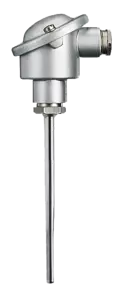

Screw-in thermocouples
- Temp.: -200 to +800 °C
- Insertion length 160 to 600 mm
- Thermocouples type J, K, and L



















Thermocouples are based on the principle of comparative measurement and consist of two metallic conductors of different materials that are welded together at the tip. Depending on the material pairing, they have different levels of thermoelectric voltage and are suitable for different temperature ranges.
The principle of thermocouples is the result of the so-called Seebeck effect. This phenomenon can be explained by the theory of free electrons, according to which different types of conductors have a different density of free electrons.
In contrast to a resistance thermometer, a thermocouple can be used in a much higher temperature range. In addition, thermocouples are more robust and resistant to mechanical stress.
How do thermocouples and resistance thermometers differ? - JUMO FAQ
The choice of thermocouple type depends primarily on the operating temperature. Furthermore, an element with a high thermoelectric voltage should be selected in order to obtain a measurement signal that is as insensitive to interference as possible.